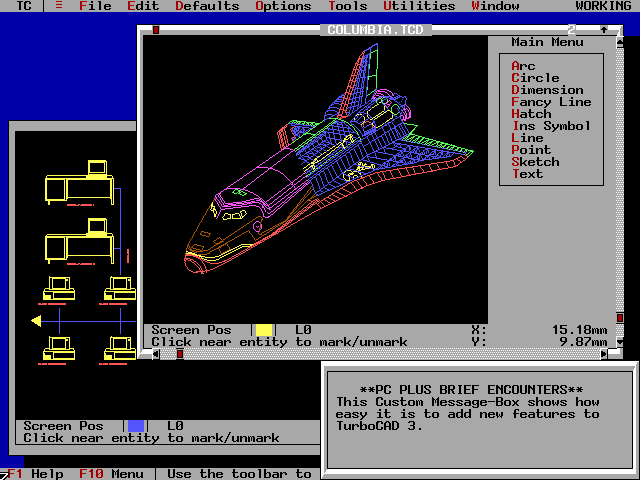| Publication Details: | |
|---|---|
| Publication: | “PC Plus”, UK |
| Issue: | 73 |
| Date: | March 1993 |
| Product Information: | |
|---|---|
| Title: | TurboCAD V3.0 |
| Supplier: | IMSI (UK) Limited |
| Phone: | (081) 758-1447 |
| Price at time of publication: | £99.99 |
| Fact Panel: | |
|---|---|
| Display Types: | Hercules/EGA/VGA/MCGA |
| Issue Disks: | Dual Media |
| Minimum Hardware: | HD/512k/Mouse |
| Other Hardware: | LIM/XMS/Printer/Plotter |

Brief Encounters: TurboCAD V3.0
TurboCAD V3.0 is the latest version of the popular 2D CAD program. IMSI have worked hard on this release: in addition to a number of enhancements, the program is now supplied with an extensive collection of Symbol Libraries.
Setting up is easy: program files are decompressed by the Install program, and video hardware is auto-sensed. Printers and plotters can be selected once TurboCAD V3.0 is running. The keyboard can be used alone, although a Microsoft-compatible mouse or tablet is recommended. Documentation includes a paperback User Manual, Symbol Libraries Reference, and Quick Reference Card.
The user interface is attractive, with lots of scroll-bars and sculpted buttons. The screen is divided into five main areas: Pull-Down and Side Menus, Prompt-Line, Drawing area, and Status/Mode area. Drawing operations are split between the pull-down and side menus, and the status/mode area: commands are selected from either menu, snaps are set from the side menu, and drawing aids are set from the status/mode area. This is confusing: the user hops constantly from one menu-area to another. Splitting the screen areas used to select drawing and editing commands feels unnatural. The structure of the Pull-Down menu needs improving: some fundamental features (such as Entity selection by Window) are buried too many levels down, and the grouping of features by topic is inconsistent. Unfortunately, the documentation doesn’t help, hiding the menu-listing in the middle of the User Manual, rather than in an appendix or on the Reference Card.
On the credit side, TurboCAD V3.0 contains a number of useful and well-designed features. More than one drawing window can be open at the same time, allowing entities to be moved or copied between drawings without having to unload the source drawing first; Library symbols can be selected graphically; HP-GL and DXF files can be read in, permitting data interchange with other CAD systems; and text can be hidden inside an entity’s definition and extracted to an external file, allowing the generation of Bills of Materials.
Unusually at this price-level, TurboCAD V3.0 includes an excellent Script language: based on the Drawing Editor commands, it also provides powerful features such as conditional jumps to labels, and tools for creating custom Messages and Radio-button selection-boxes. These features could be used to create some quite clever ‘turnkey’ CAD applications. It’s not as sophisticated as AutoCAD’s AutoLISP, but at the price it’s first-rate.
TurboCAD V3.0 is a mixed bag. The user interface is attractive but confusing, while the script language and multiple drawing windows provide rare sophistication. Ultimately, this product is worth persevering with to enjoy the powerful features behind its pretty face.
Tim Baty
Verdict:
For:
- Excellent Script Language
- Multiple Drawing Windows
Against:
- Confusing Menu Structure
- Limited selection of Display and Pointer hardware
| Score-Card: | |
|---|---|
| Range of features: | * * * * * |
| Overall Speed: | * * * |
| Ease of Use: | * * |
| Documentation: | * * * |
| PC Plus Value Verdict: | * * * * |